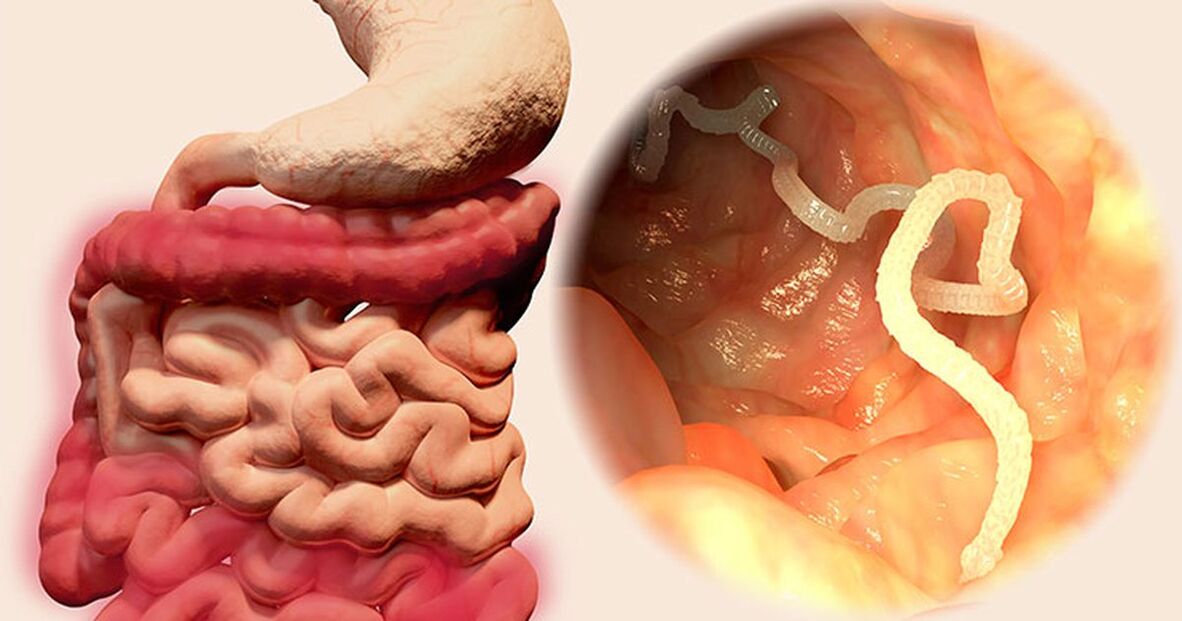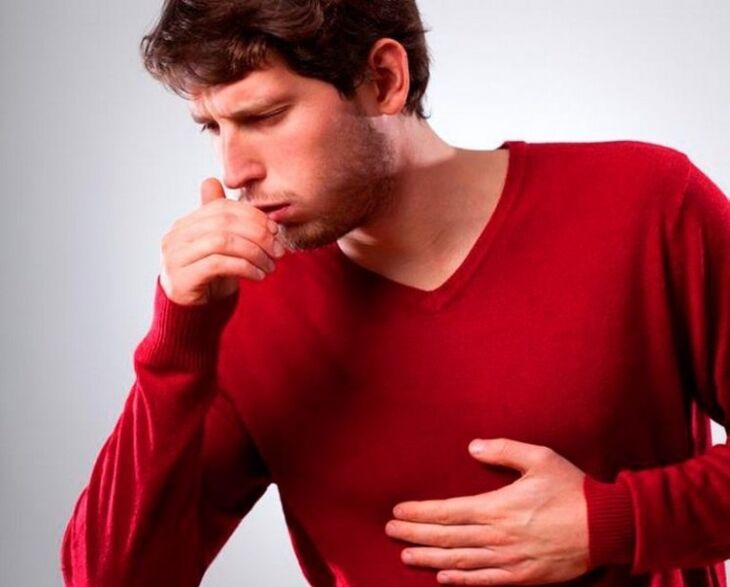
Human parasites inhabit any of its organs and systems. These creatures enter the body from the environment and spread through the bloodstream throughout the body. There are a huge number of types of parasites that can settle in the human body. They all pose a threat to human health and cause negative changes in organ function.
Human parasites. Signs of worms in humans are obvious and hidden. "Unreasonable" weight loss, pale appearance (skin anemia), chronic fatigue, night itching in the anal canal are obvious. These manifestations are well known and indicate contamination.
How can you get infected with worms
Human parasites. To protect yourself, you need to know about 4 ways to spread and infect worm eggs:
- Through soil and water - geohelminthiasis. They develop in sand, soil and water and then enter the human body and start laying eggs there. Furthermore, worm eggs along with feces enter the external environment and wait on the wings to infect a new person. Eating poorly washed vegetables and fruits, dirty hands, food dust can lead to human infection with geohelminths. Some parasite eggs enter the human body through the skin of the feet and ankles.
- Direct contact. Worms in pets and humans are transmitted through hand contact, games and joint activities.
- Using contaminated food of animal origin - biohelminthiasis. Consuming raw and poorly processed meat (kebabs, bacon, canned food, home-made game) and fish (sushi, dried fish, canned fish) is potentially dangerous. There is a possibility of infection with intestinal infections and biohelminths.
- With an insect sting. This type of infection is quite rare. These include intestinal myiasis, cantariasis, and scoliosis. Do not mix parasite eggs and insect larvae, which also settle under animal skin and human skin (for example, gadfly larvae).
The main mechanisms of worm spread
- Soil, sand and other types of soil are the most fertile habitat for worm eggs. The fruits are in constant contact with the ground. During the harvest, greens, fruits and vegetables come into contact with the hands of workers, with dusty shelves of vegetable stores and trucks. In such conditions, the contamination of food with parasite eggs is high. Therefore, it is necessary to wash the products of plant origin well under running water, and then pour boiling water over them. One should be especially careful in the countryside, where pets walk around the yard and then enter the house. It is not difficult to imagine what kind of sewage a cat or dog can put in the house after a night walk. Flies and cockroaches are also carriers of helminth eggs. When you sit on food, insects can infect your food. Any contact with soil and sand can lead to the entry of parasites into the human body. Therefore, it is necessary to wash your hands thoroughly, especially under the nails. This is especially true for children.
- From person to person. This mechanism of infection is very effective. For example, pinworms lay eggs in the area around the anus at night. The child, in a state of sleep, scratches the place where the eggs are laid, because that is where the itching begins. Thousands of eggs fall on clothes, on the bed, and in the morning on the handles and on everything that the little fidget touches in the morning and before he washes his hands and washes his face. As a result, the whole family is at risk of infection.
- In contact with water. Open water bodies contain a huge number of worm species. Bathing and accidental ingestion of water pose a serious risk of infection

Children are more susceptible to helminth infestation much more often than adults. This is due to the fact that the child's organism is poorly protected (defense mechanisms are still being formed), and the child is actively in contact with the external environment. It takes incredible effort for parents to teach him the basic rules of personal hygiene.
A baby under the age of 6 is at high risk of infection. According to statistics, about 95% of children under the age of 4-5 are infected with worms. Therefore, it is necessary to pay special attention to prevention.
Most species of worms are found in the body, only lay eggs there and die after a certain time. For example, pinworms live 6-8 weeks, roundworms - up to 1 year. The number of parasites in the body increases only with the entry of new eggs from the outside.
The treatment allows you to get rid of worms much faster and stop laying eggs in the intestines. It is almost impossible for children with helminthic infestation to recover without medication. New eggs will constantly enter the oral cavity, filling the rows of adults in the child's body.
What are the signs to recognize a helminthic invasion
It is not uncommon for helminthic invasion, in which diseases of internal organs are exacerbated, diseases that have not previously manifested. This is considered a hidden sign. Man is led to the treatment of many diseases, and the cause is left unattended. At the same time, therapy does not bring results. Here are examples of such cases:
Infectious diseases as a consequence of reduced immunity
Parasites, being in the human body, consume a lot of nutrients and release toxic substances. Such circumstances significantly reduce the patient's immunity. Exacerbation of chronic diseases, various inflammatory processes in the nasopharynx may begin. Treating sinusitis or stomatitis in the standard way is pointless. It is important to rule out the cause.
In girls and women can often begin inflammation of the uterine appendages, vulvovaginitis, vaginosis of various origins.
General weakness as a result of intoxication of the body

The more severe the helminthic invasion of the patient, the more harmful parasites are released. It has a detrimental effect on the well-being and nervous system of adults and children. An example of this is migraine, dizziness, joint pain. Overcoming nausea, the person takes painkillers, but the pain returns after a short time: the cause of the problem is neglected.
In children, nervous system disorders are accompanied by irritability, apathy and aggression.
If your child has started to sleep poorly, talk in their sleep, see nightmares or slipped into school, then it is time to start preventing helminthiasis.
Allergic reactions, skin pathologies
Human parasites. Worm waste products are perceived as triggers for allergens. Skin reactions (rash, itching, rash, peeling of the skin) are the minimum symptoms that can occur when the allergy starts. There is a possibility of general reactions of the body: worsening of asthma, rhinitis, cough. Sometimes helminthic invasion is accompanied by brittleness and hair loss, cracking of the skin on the heels and peeling of the nails.
Gastrointestinal disorders
Depending on the severity of the infection, symptoms can range from mild to severe forms of the disorder. From mild nausea and diarrhea, to chronic bloating, constipation, vomiting, navel pain and hypochondrium. Tissue worms do not affect the gastrointestinal tract as much as intestinal parasites.
In which organs can parasites live?
Human parasites are divided into two categories, which correspond to the site of activity in the donor body.
- Cavity - worms that live in different parts of the gastrointestinal tract. There are about 100 species of intestinal parasites, and there are several dozen species for each part of the gut. The small intestine is ready to accept roundworms, antilostomes, broad bands and other less common "brothers". The small intestine will "share living space" with pinworms, dwarf tapeworm and others. The medical literature describes cases where one person was infected with several types of parasites at the same time.
- Tissue - worms localized in organs, tissues, and even in the blood. Modern medicine successfully copes with paragonimiosis (lungs), cysticercosis (brain), echinococcosis (liver) and filariasis (lymph vessels). Some worm larvae move through the body through the circulatory system and randomly attach to any organ. If many eggs are ingested, the whole body can be infected.
Worm symptoms depending on the type of parasite
Symptoms will vary for different types of worms in humans. It is also worth considering the duration and severity of parasite infection, the general condition of the patient before infection. The table below summarizes the main symptoms of the presence of worms in humans according to their species.
> zxtable border = "1" cellpadding = "0" >The symptoms of helminthiasis are diverse, such as the pathogens of parasitosis, their life cycle, entry routes, migrations and favorite localization are different from each other.
The general symptoms of parasitic diseases are explained by the fact that in helminthic invasions, parasites suppress a person's own immunity, contribute to the development of inflammatory and autoimmune processes. General symptoms are associated with intoxication, death of parasites, their vital activity and reproduction, manifested as weakness, lability and mood swings, decreased academic achievement and performance, memory and learning ability in children.

Pain in the right hypochondrium, bitterness, jaundice may indicate that the parasitic disease is localized mainly in the hepatoduodenal zone (liver and duct area). At the same time, the patient may notice nausea, episodes of regurgitation (vomiting).
Human parasites associated with damage to the liver and ducts belonging to the hepatobiliary system are observed, for example, when infected with flatworm - opisthorchiasis. This helminth enters the body of the final owner - a person - when it eats poorly processed fish of certain breeds (carp).
Symptoms associated with liver and duct damage related to the hepatobiliary system are observed, for example, when infected with flatworm - opisthorchis.
The disease is endemic and has special areas of spread. To transmit the pathogen, the larva of the parasite must go through a complex cycle with a change of host (mollusk of a certain species, fish from the carp family).
Human parasites. Many parasitic diseases often have certain skin manifestations in the form of itchy skin, various rashes, scratches, atopic dermatitis, eczema and other skin diseases. Skin processes are not always associated with helminthic invasion and are unsuccessfully treated by dermatologists.
It is important that helminthiasis can affect all organs and tissues, patients are often worried about headaches, arthralgia (joint syndrome), and there are problems with the upper and lower respiratory tract. Often, prolonged cough, frequent SARS, pharyngitis, laryngitis, shortness of breath are associated with inflammation, a key place in the pathogenesis of which is the infection with parasites (helminths).
Giardiasis and its characteristics
Giardiasis is a protozoan disease in which the pathogen exists in vegetative form and in the form of cysts. Giardia infection is caused by the introduction of cysts that are very persistent in the environment and can survive for a long time in the environment (soil, food, water, various objects).
1 ml of feces can contain millions of lamblia cysts, which, when placed in a favorable environment, can be transformed into vegetative forms. In the human intestine, a vegetative, mobile form of cysts develops over several hours with flagella attached between the cells of the intestinal epithelium, where the causative agent finds a favorable environment for itself with sufficient carbohydrate food, which is a favorite substrate. for lamblia.
Giardia are divided binary (into two parts) in a favorable environment, and soon their number multiplies. In addition to the intestines, vegetative forms of lamblia affect the hepatobiliary system (bile ducts, gallbladder).
Symptoms of giardiasis are associated with asthenia, poor academic performance, weakness, combined with signs of damage to the intestines and hepatobiliary tract. The course of giardiasis and other parasitic diseases is largely related to the characteristics of the immune response. Intestinal form, gastroenterocolitis - a common form of giardiasis. Pathogen endotoxins can affect the nervous system, which explains the presence of many common extraintestinal symptoms.
Ascariasis
Another common and ubiquitous parasitic disease is ascariasis. This helminthiasis is more common in children, but often causes many problems and symptoms in adult patients. Many chronic inflammatory diseases, as well as somatic pathology, can be triggered by parasite invasion and intensify in the presence of various parasites (including ascaris).
Chronic colitis, enteritis, bronchitis often develop in children and adults who carry ascaris, and even such a serious disease as bronchial asthma can develop, and other allergic processes (atopic dermatitis, eczema, rhinitis, psoriasis) can be supported.
Human parasites. Ascaris enters the stomach when eggs are swallowed. After entering the upper parts of the digestive tract (stomach), the larvae, releasing the capsules, migrate into the blood vessels, enter the alveoli of the pulmonary system through the bloodstream, causing coughing, coughing and other phenomena of bronchitis.

Often such a condition is considered a viral infection, an exacerbation of chronic bronchopulmonary disease and is usually in this case associated with the movement of parasite larvae.
After expectoration of ascaris larvae and introduction of pathogens from mucus into the pharynx, they are swallowed with saliva and re-enter the stomach, and then pass into the intestine, where there are favorable conditions for further growth and development of parasites.
In the human intestine, roundworms, feeding on its contents, turn into sexually mature individuals (female 50 cm, male 20 cm). In the process of growth and vital activity, as well as as a result of larval migration, the parasite has a negative toxic and mechanical effect on the human body.
In the process of growth, vital activity, egg laying and maturation, the pathogen has a suppressive effect on the body's immunity, can cause diseases of the lungs, intestines and other parts of the digestive tract, anemia. Ascaris can live in the human gut for up to a year.
Remedies for helminths
Treatment of a person with tablets is possible with the help of a large number of modern anthelmintic drugs, which are prescribed by a specialist.
Since some agents do not affect the larvae and eggs of worms, and there is a high risk of reinfection (self-infection of pinworms), the course of treatment is repeated after 2-3 weeks. Among the folk methods, the most effective are the old proven methods - the use of pumpkin seeds and tansy grass.
It has long been known that pumpkin seeds are a good anthelmintic, it is best to buy unpeeled seeds, peel them yourself, preserve and eat a thin film between the seeds and bark, and consume 300 g in the morning. . within an hour, pre-chopped and mixed with honey or jam. Then do not eat for 3-4 hours and make an enema, you can repeat this treatment after 2 weeks.
Interesting facts about human parasites
- According to the WHO, about 3 billion people are infected with helminthic infections every year. 1, 2 billion suffer from enterobiosis, 0, 9 billion from hookworm, 0, 7 billion from trichocephaly. And this is just an official statistic !;
- In European countries, every third inhabitant carries intestinal parasites in the body;
- In severe invasions, a person loses up to 500 ml of blood per day. This is where diseases and chronic fatigue come from;
- Some parasites are localized in the brain, eyeball, bone marrow and can live there for up to 30 years. For example, cytisteryk;
- Ascaris females lay 240, 000 eggs a day. Constant reinfection will not allow a person to be cured for the first time. Repeated courses of treatment are needed;
- Waste products of parasites - poisons and toxins - undermine human health 24 hours a day;
- Some species of tapeworms reach up to 12 meters in length. Sometimes it threatens to obstruct the human intestine;
- Pumpkin seeds contain cucurbitine, which helps treat worm infestations without resorting to drugs. Pumpkin seeds are often given to children for prevention;
- It is optimal to treat pets every 3 months. This will save yourself and your children from parasites;
- Worm eggs can wait in the wings on door handles for up to 6 months;
- An infected dog scatters parasite eggs by breathing within a radius of 5 meters;
- In order not to be digested in the stomach and intestines, worms and their eggs release protective anti-enzymes;
- Trichinella does not lay eggs, but produces ready-made worms. Therefore, it is impossible to detect the presence of this parasite in laboratory conditions;
- It is considered that the most effective test for detecting invasion is the enzyme immunoassay. Swabs, stool analysis may not provide reliable information.
In summary, regular prevention of helminthic infections, even with cheap drugs (they are also considered the most gentle), helps protect the whole family. Be responsible for hand and body hygiene and thoroughly prepare food for use. Children and pets need constant monitoring for parasites.
























